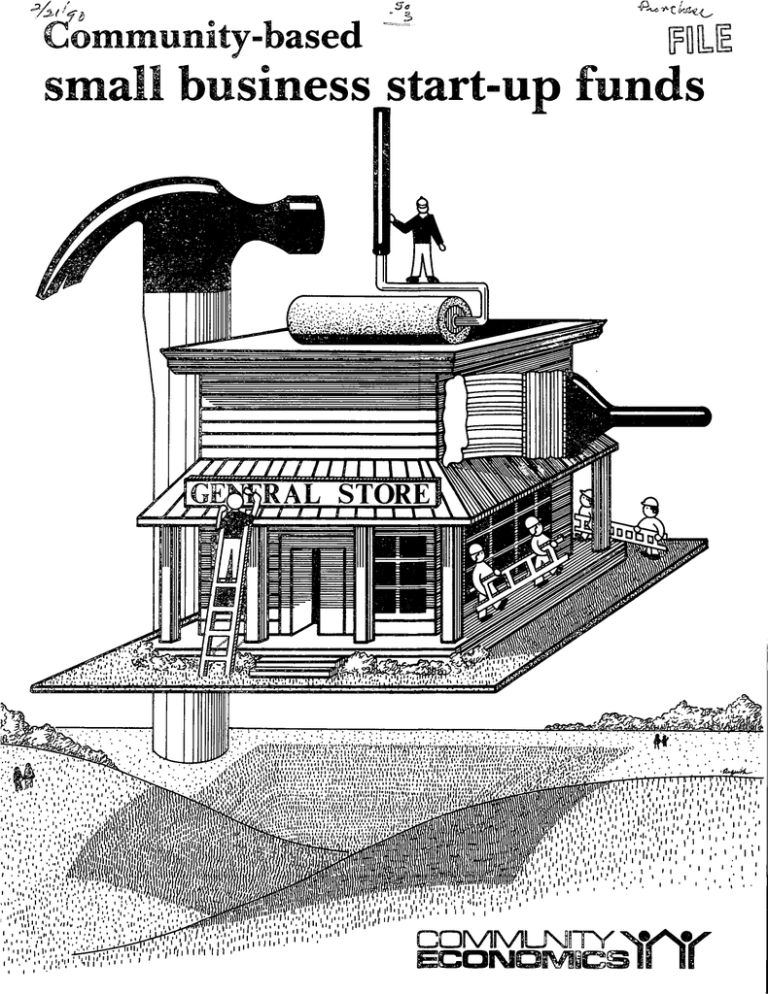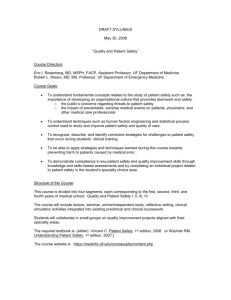small business start-up funds ~" jpQU
advertisement

*/*<,\ Community-based ~" jpQU small business start-up funds # t rrtha* i ■■ g^u. : .■.....••. • .,.•..■■■•:..,,,.,.,•.•.■ ........ i :■'.• • : ' • Mr • • ' • ■ • .' - :.'-':. ' ■ ; ; ^■^'•W^ i'lM'tytti-'i.-n k-mti Li\1.$ mm i! O.Vr.'itV.l I'l't-vniiiuii't.'. KiAHMiM'MI; ww0-y?!■.'■■/.'■I ■ !(■ I II ll /l I llilJlU ?;i^N^;.!.'!ijv;'.\',/.,:!',;''.'.'ii' ■i. i.1 ,',1,1, i i'!' iV'"'1 V';^* ^lii^^fef: feri '-'> ■■■' ■'S'l'V;^*^^ 'l I I ' ' l' ' 1 ( ' I1 11 I1 ''. ■'" 1 11 '.i ' ''. vii i' •' * il I'l ' ' i | I It I/I i', •'. 'i, I.I." in i' 1 .'.'i ''' i'1111.1 1'! ''II' ' i , i' • i'II '' ,' 'in1111'■. '" i,11' i COMMLNITr EOONOiVilOi '. i . ' i ,i .i i' •■ ii ' Lloyd D. Bender Program Director Survey Research Center Montana State University Cover drawing by Anna Asquith Contents Setting the Stage Seven Major Pitfalls to Avoid Start With a Business Plan for a Local SUF Decide What the SUF Will Do Determine How Large Your SUF Will Be Decide on a Business Organization Form Define the SUF's Investment Objectives Define the Investment Instruments the SUF Will Use Find a Source of Funds Cover Your Legal Liabilities Consider Other Possibilities Organize the Community Into Action A Personal Checklist for Community Participants 3 4 4 6 7 8 8 9 9 10 10 11 11 Many small towns are considering communitybased start-up funds to foster the development and retention of small businesses. There are no hard and fast rules to follow in setting up and operating a start-up fund. Each community needs to take the time and effort to design its own fund for the purposes that the community choses. Even very small communities can play an important role in local economic development, whether or not they provide all of the primary functions usually associated with a start-up fund. In fact, small communities should consider using a building block approach to begin establishing a start-up fund. The first step is to initiate a small business planning assistance program to help new business people prepare for starting their enterprise. The second step for a community is to help provide financial and service resources to small businesses, either by recommending financing routes, making loans or equity investments, participating with banks in making loans and other financial arrangements, or simply establishing a service incubator. The third and last step that will round out a full-service start-up fund is management oversight through each phase of a business' growth. The very smallest community can take the first step without risking capital. Success with the first building block—a small business planning assistance program—will help the community decide whether to take the second step. A successful community start-up fund should be a long term investment in the community. The fund's first objective should be protecting the integrity of its capital base. Its earnings must be large enough to make up for inflationary erosions of its capital, to cover its investment losses, and to support its operating expenses. Small communities may be able to operate a successful start-up fund even with a very low capitalization by trimming operating expenses and making prudent investments. The level of operating expenses depends on how the fund provides its services. Successful small funds in a rural environment use volunteer local professionals to perform many functions. Other small communities maintain a group of community-based professionals who perform the fund's occasional services on a fee basis. Whether the community is large or small, a group must be well-organized before it begins to make decisions concerning the design and purpose of a small business start-up fund. unding of local economic development efforts has come under severe pressure due to changes in Federal laws, regulations, and budgets. Municipal bonds have typically been a source of development funding, but today their use is limited by recent legislation. Programs of the Economic Development Administration and Small Business Administration have been cut drastically. Incentives for local banks to purchase debt obligations of local governments also have been eroded by legislation. Finally, the treatment of capital gains as ordinary income has reduced the incentive of individual venture capitalists to search out and to fund the creation and expansion of small businesses. Under these conditions, new community approaches to local economic development are dictated. The approaches of the past centered on attracting large plants of multinational and national manufacturing firms to a locality or state. The mechanism was usually the provision of low-cost debt capital. Often a plant's non-depreciable assets were subsidized by providing low-cost land, or low-cost access to the plant and to facilities such as water, sewers and fire protection at low cost. Today's competition for plant relocations is so great that few rural towns will be competitive. It's no longer an attainable goal for most local economic development efforts. Small business start-up funds are now gaining attention as an avenue for local economic development efforts. Much of the employment increase in the nation is generated by new and expanding small businesses. The popularity of start-up funds recognizes that fact. Local start-up funds, called SUFs for short, provide capital and other resources to new and expanding businesses. Although the concept of an SUF sounds sensible, getting one started and keeping it going isn't easy. This primer highlights the main points a community should ponder before even starting on the long path to establish, operate, and maintain a local SUF successfully. It assumes that your community has decided to consider an SUF. The next step is to ask a series of questions as a way of preparing for critical decisions. This primer raises some of those questions. The discussion in each section of this primer gives some alternatives, possibilities, or advice that will be quideposts for your decisions. Ultimately the community will have to decide the goals of its SUF, and how it will be set up, structured, and operated. SeMnng may have important functions that it can serve. A few reasons that banks may shy away from small business loans are: * Very small loans can cost banks more than they stage Have some A community-based SUF will contribute to local economic development, but economic development can have a variety of targeted goals. The more specific the economic development goals, the easier it will be to defend the SUF concept as a part of local development efforts. It will also be easier to chose the SUF's mechanisms, the projects that will be eligible for SUF assistance, and to measure the SUF's contribution to development. Employment and income are commonly mentioned targets of economic development. Community goals can be expressed in different ways, such as: Employment Increase total employment. Increase skill levels ofjobs. Increase job opportunities for a defined group (i.e. minority) Income — Increase total income. — Increase income per employee. — Increase the members of a defined group who have income. Each group of participants in a community will have different incentives for promoting economic development, and their agendas may be masked in rhetoric. For that reason, each of the above goals may be supported by community leaders for different reasons related to their self-interest. Below are examples of some of the hidden agendas you may encounter. Examples of Participants School administrators, government officials Real estate developers Mall developers Long term residents Taxpayers Examples of Participant's Goals -Increase the tax base. -Increase land values. -Bring in more people. -Keep the status quo. -Keep taxes down. Defining economic development goals will help put together a coalition of community people in support of an SUF and its contribution to economic development. Is a local SUF needed to achieve the A local SUF must fill some vacant niche in the community's economic system in order to justify itself. There may be a number of lending institutions available, for example. The obvious question is what a local start-up fund can do that banks don't. If banks service all credible local investment projects, the SUF will either compete direcdy with local banks, or it will be taking on only high risk loans that local banks will not fund and thus it will be subsidizing businesses. An SUF won't survive long competing with an established bank for customers, and high risk loans mean that an SUF's investment capital will eventually be lost. Banks may have good reasons for not servicing all credible local loan projects. When that is true, an SUF pay. * Untried products will not have a track record that banks can use to evaluate the probabilities of success. * Banks may be uncomfortable making investments in enterprises with which they are not familiar, even though the enterprise may have proven itself elsewhere. * Banks have a large number of national investment opportunities that may pay them more than profitable, local-enterprise loans. * Banks may want a diversified portfolio of loans and may not be able to serve all small businesses for that reason. * Banks usually will not provide financial advice to customers because of the liability incurred. * Banks also want to see a business plan already prepared and do not want to participate in helping formulate business plans. The current economic development emphasis has shifted to home-grown firms—the expansion and retention of small firms that are basic to an area's economy. The mechanism has also changed. More equity and less debt capital is needed, since small firms typically cannot handle additional debt. Banks do not pardcipate directly in equity positions, but additional equity (or near equity) provided by an SUF adds resources to a firm's balance sheet and once that is in good order, bankers willingly service the debt needs. Providing equity capital, or participating with banks in loans, are important niches that local SUFs can fill. They can provide small businesses with start-up and expansion funds that aren't available from other sources and act in concert with the community and with banks. An SUF need not compete with local banks. K.jMy»»a«>jui.i,j»mi^jiimhjji,.u» ■,i>jgj«L-«fl,.r«Tjji.'y;Ti^.yTjfig? ;-;%j».fi.ira..-;r-.3.7.T The Great Falls Capital Corporation was organized in 1985 under Montana laws. The objectives are "... to earn an adequate return on investment, to provide additional jobs in the Great Falls area, and to offer the potential for increasing job opportunities through the growth of businesses acquired or invested in by the company, and those that provide support services or products to such acquired businesses." ,\VMBa^'ia«aaAMa^t;ai^y^iiy-.a>-t»-<\'«i<'.'.i.?g^ : rrj,ffn:.v.-,atyn ■•mt.' - .:...■.■ i., How can an SUF he the least threatening to the community businesses? Northeast Regional Rural Development Center The Pennsylvania State University University Park, PA 16802 An SUF is meant to change the economic system of a community. Leaders will have to defend the SUF by showing that it doesn't threaten community businesses. Will the SUF take business away from bankers? Will the SUF fund firms that compete direcdy with local businesses? Will the SUF conflict with state programs? Will the SUF result in higher taxes? Will the SUF change the political balance in the community? Southern Rural Development Center Mississippi State University Mississippi State, MS 39762 Common sense dictates rules to follow in order to ensure that your SUF will be the least threatening to community members. The first rule is to fund operations that clearly export goods and services to other areas and that do not compete head on with local businesses. Funding local merchants, even those that might attract more people to shop in the community, or result in people shopping locally rather than going out of town to shop, will tend to threaten existing local businesses.The second rule is to use the SUF's funds to get a firm's balance sheet in good shape so that the local banker can then loan funds to the firm, aiding rather than competing with the bank. In addition, an SUF's funds will go further if they are leveraged by a bank loan. The third rule is to involve the community as much as possible in the SUF's decisions regarding loans, equity, and grant investments. Broad involvement in the venture not only builds community spirit, but also tends to ensure that the SUF's business clients remain in the community and operate to the benefit of the community. Seven major pitfalls to avoid What errors have other SUFs made? Get the experience of others before starting an SUF plan. So many new SUFs and small business development corporations have been established that there is an abundance of experience to draw on, Get wired into that network. The economic development specialist in your state's Cooperative Extension Service is one place to start. A listing of these is provided in the appendix. The Business Assistance Division of your state Department of Commerce is another. Revolving loan funds are operated by 25 states, and 20 states have rural incubator programs. A regional focus and connections with national organizations are provided by four rural development centers in the nation: Western Rural Development Center Oregon State University Corvallis, OR 97331 North Central Regional Center for Rural Development Iowa State University Ames, IA 50011 Several national organizations follow the development of start-up funds, their problems, and successes. At the very least they can direct you to other organizations and programs. The National Development Council in St. Louis, Missouri, provides training relating to local economic development financing, and provides assistance in designing and developing small business financing programs. The National Association of State Development Agencies in Washington, D.C., monitors and reports state level activities. The Urban Institute in Washington, D.C., keeps abreast of policies affecting urban areas. The Small Business Administradon not only carries out programs, but can provide educational material and advice at the state level. Listings of state and local business development corporations can be obtained from the National Association of Small Business Investment Companies in Washington, D.C. The task at this point is to keep making telephone calls and writing letters in order to get all of the information available on reasons for SUF successes and failures. Below are a few of the most common errors made by local SUFs. Poor use of available investment instruments: The greatest single mistake of local SUFs is that they tend to make simple loans to businesses rather than getting additional leverage from their money. Many times loans will be unsecured. More times than necessary, loans will be made to a poor business risk, resuldng in losses to the SUF. In order to survive, the SUF must keep its capital intact, and must expand its loan fund. In order to do that, it must retain a keen business sense and use all available investment instruments in order to secure its share of profits and minimize risks. A very wide range of investment instruments is available for use in today's world, and these are discussed below. Any number of combinations of investment instruments can be used in any one deal. The point is that the investment package should be designed to minimize risk to the SUF on a case by case basis. The region served is too small A small town or county by itself may not be large enough to provide a local SUF with capital, or with investment alternadves. The amount of capital that must be invested in order to provide an SUF with operating funds will be indicated by your business plan. The SUF will not be able to serve everyone who walks through the door. In fact, it will have to screen its clients very carefully, and only a few will qualify for investment help. A large region may be necessary in order to find enough qualified applicants. A service region may be too small to produce enough profit to pay operating expenses. least, a management expert must be able to judge whether the new or expanding venture is keeping up with its projected schedule and is maintaining its revenues and expenditures as planned. Loaning to footloose firms Footloose firms pose a problem. These are firms that can locate almost anywhere that cheap labor or liberal subsidies are available. Examples include low-wage Lack off imdhistry diversiEcatiom Rural areas often have a very specialized economy, labor-intensive firms such as garment factories, and such as timber or some type of farming. If an SUF caters firms that produce a high value product that costs litde to ship to consumer locations. The problem is that primarily to people in such specialized industries, it footloose firms can easily move if incentives from becomes vulnerable to the ups and downs of that another town or region are more attractive than at their industry. For example, declines in the price of timber current location. A very close screening of firms will and timber products could affect loan repayment schedules of firms in the industry. An SUF could suffer minimize this problem, but the chance of landing a large plant, even though it is in a footloose industry, is often financial losses if several of its loans default. The same reasoning holds if an SUF specializes in financing retail too seductive for local officials to turn down. businesses. Any major regional or national recession that made those businesses fail would mean financial losses to the SUF. An SUF should attempt to diversify its portfolio in several different industry types in order to insulate itself from the possibility of loan losses that are uniquely associated with events in each industry. ■^ he community has to prepare a business plan for its SUF—how it will work, what it will do, its Single plant loams business organization, its goals, ways to attain The greatest temptation of local economic developers goals, and a systematic means to evaluate the local SUF's is to use most of a community's available capital to lure progress. The business plan will also budget the SUF's one large plant into a region. SUFs face the same costs and expected revenues, and project a time schedule temptations. If the SUF has all of its funds invested in for changes in the operation as it progresses. These the plant, and the firm fails due to mismanagement, missed demand projections, or a recession, the SUF will provide a means to evaluate the successes and failures of the SUF, and also signal unexpected results leading to also suffer. decisions that will have to be made in the management and operation of the SUF. Undercapitalization Too low capitalization of an SUF can be just as serious as trying to serve a region that is too small. The guideline is that the cash flow of the SUF has to be large enough to support its operating expenses, and to make The Great Falls Capital Corporation will up for non-participating loans, defaults, and inflation if acquire majority control of businesses outside it is to maintain a constant or growing level of the Great Falls area and relocate all or a part of investment funds. A very small SUF may be forced to those businesses in or near Great Falls to operate using voluntary labor if its cash flow is achieve its economic development objectives. inadequate to support a professional paid staff. A highly The company does not intend to resell acquired capitalized SUF is required if functions such as businesses, but to hold them for a long-term management oversight, provision of ancillary business investment. services, and start-up consulting are to be provided by In addition, the company may invest the SUF in addition to financing. through equity or debt instruments in companies in which it does not acquire a Lack off oversight controlling interest but which are suppliers of An SUF must be able to both identify entrepreneurs services or products to its acquired businesses. with good products and ideas, and to follow up on those However, such investments will be very limited businesses that are funded. Professional credit analysis to avoid being subjected to the Investment skills are absolutely necessary in order to keep tab on the Company Act of 1940. progress of investments. Furthermore, the skills of a The company will limit its investment in any technician or engineer may be required to oversee and one business to 25 percent of the company's evaluate the business management. Seldom does an stockholder equity to remain diversified and to SUF's staff have skills to evaluate each and every product meet the capital corporation laws of Montana. or idea, or to track a company's progress. At the very Start witSn a Ibegieess plaim ffor a local SUF n Has the community made a business plan for an SUF? Following are essentials of any business plan: Mission Functions performed Schedule for organizing the SUF Form of business organization Size of the organization Sources of start-up money Sources of investment capital Eligible investments Who will be the Board of Directors The size of the staff How clients are selected Type of operation qualifying Financial instruments to use Model financial packages Marketing plans Schedules for judging progress Overall portfolio alternatives Portfolio objectives Pricing policies Organization of the staff Measures of progress/success Some of the most important decisions in making a business plan will be discussed in the sections that follow. Decide what the SUF will do full-service SUF will have three primary functions. * Start-up planning assistance * Financial and other resources * Management services and oversight A' Along with the entrepreneur's own personal finances, labor, and experience, most small businesses start with a concept or a product. The leap from concept to a profitable business operation is often a rocky road that's impossible to travel without outside help with financing, business assistance, and marketing. A community SUF can include all of these functions. Which functions should a community Start-Up Fund provide? Start-up planning assistance The availability of start-up planning assistance is a fundamental part of any local business development program. If not already available locally through cooperating agencies, or if not accessible in a timely manner and at a reasonable cost, then such planning assistance to new and expanding small businesses is an absolute necessity for a community SUF. The first task for every new business is to make a plan so that the business concept can be explained in detail—its goals and how to attain them. Most importantly, it is a firm's map for bankers, venture capitalists and members of the community. The lack of a business plan is the single most important reason small businesses cannot get financing. Financial, property, and machinery resources Small business investments may provide financial support or supply inexpensive access to real property. There are numerous ways to deliver them. Financial resources can be provided through loans, or by actually buying into the business. Equity capital is provided when a business sells stock, or when someone buys into a partnership. An equity investment means that the investor actually becomes a part owner in the business. Proprietors of small businesses often do not have the personal resources to handle a new business by themselves, and new small businesses may not have enough assets to be able to borrow money from commercial banks. However, if someone buys into the firm, the balance sheet may be improved enough for the banker to consider loans. Equity capital is the primary need of new small business firms because they often cannot make enough profit in the early years to pay interest on borrowed capital. Loans to a firm may be made in any number of ways. Unsecured loans are simply promissory notes, and the laws of each state determine what recourse lenders have if the borrower defaults. Usually loans are secured by property of the borrower, and default results in loss of the property. If a small business has little property, the chances of getting a conventional loan are low. In that case, other forms of financing are still possible. Participating loans give the lender some part of business profits in the future. The proportion of profit and the participation time is negotiable in the same way that interest rates are negotiable. For example, a loan may be made to a firm in return for part of the proceeds from patent rights. Or in the case of a developer, profits from a real estate development may be shared. Various financial instruments, such as warrants to buy stock in the future at a low price, can be part of the deal. In addition, bonds and convertible stocks can also be substituted for a loan. Finally, making loans in cooperation with a local bank, and guarantees of loans, can stretch the limited financial resources of an SUF. All combinations of instruments should be considered in a packaged deal. Real property leasing, and grants of property are valuable avenues for supporting a new or expanding firm because it can free up a firm's operating capital. Real property cannot be depreciated as machinery is, hence it cannot be used as a cost of production in calculadng taxes. Furthermore, a firm need not pay taxes on real property if it is not owned. Industrial parks have often given new firms space, or leased space, sometimes at low rates, to new firms. The business capital released can be used by a firm for other purposes. Leasing property allows an SUF to retain tide yet gain a continuing source of revenue. Machinery leasing may also provide revenue to an SUF while aiding a small business. However, a firm can lower its income taxes by depreciating and writing off as expenses machinery and equipment that it owns, so leasing machinery and equipment is not an efficient method of freeing up a firm's capital for other uses. Management oversight There are two kinds of management oversight that can be provided by an SUF—participation in management decisions, and provision of office, accounting, and legal services to a group of small businesses in order to minimize their costs. Participation in management is essential to an SUF that does equity financing. The SUF's equity in the new or expanding firm must be protected. It needs to know what the firm is doing, how it is being accomplished, and what the end results are. And such information is needed on a month to month basis. An SUF's investment will pay off only if the firm does well, and as part owner, the SUF is responsible for that. Finally, the SUF won't survive unless its investment positions return a profit. Thus, an SUF must have management expertise available for routine decision making as well as evaluations of the progress of each firm in which it has an interest. Shared facilities and services among a group of small businesses is another method of aiding small firm management. This is the "incubator" concept that can be a very important part of an SUF. Facilities and services may be provided by the SUF, or with a team approach, by cooperating businesses in the community. Setting up a group of services that is shared by many local small businesses can be an important function for a start-up agency, whether or not it invests in local businesses. mine how 1 will Ibeo yomiir nee the SUF functions are chosen, the manner in which those functions are delivered determines operations expenses. The level of income from the SUF's investments must be adequate to support its operations expenses. How much income 'ow must an SUF 9 to support its oj The volunteer SUF An SUF may use only volunteer labor in order to keep its operations budget small. The staff may meet infrequendy at a central location to minimize costs. The informal nature of many volunteer organizations may mean that oversight of the SUF's investments can be done as a part of everyday affairs. However, the volunteer type of organization is best limited to straightforward and small investments among immediate members of the community. The Bitterroot Valley Development Corporation started with very limited capitalization. Its size prohibited hiring a staff. It has operated successfully several years with only volunteer labor. The community team-operated SUF Some communities are organized and cohesive enough for business people to band together in order to staff the SUF. In such cases a full-service and highly capitalized SUF may be organized while expenses are still minimized. Lawyers, accountants, managers, technicians, and bankers either charge a nominal fee or volunteer their time. Each serves a specialized function in the SUF—screening and evaluating prospective clients, deciding amounts to invest in each venture, overseeing investments and monitoring a firm's progress and problems. At the heart of such a team is a skilled professional manager who is capable of keeping the team together and the volunteers working. Thus, the community-team type of SUF organizadon is several steps higher in complexity than the simple volunteer organizadon. '.yJlr,-: The Butte Montana incubator operates using a community-based team of business people who provide services on a voluntary or fee-based system in support of the incubator's businesses. '^*r.i-*^il!fH-„-\l:*t.aW\^!^^\..^J&*»M*tm*M.*xr*^i*l\l, The self-sepporting SUF Only large SUFs are able to hire professional management and expertise and even they must contract with outside professionals for advice and management assistance in many cases. The evaluation of a new product or producdon process, for example, will require marketing experts and engineers that SUFs do not have on their staffs. The operating costs of a self-supporting SUF must be carried by the return on its investments. Risks must be managed so that the cash flow of the SUF will not be endangered. The self-supporting SUF comes nearest to being a commercial bank or venture capital firm than any of the other types of SUF organizations. ..■.a JL -•■ ■:.'.'-.-■■: ,J<Vi'-.vt.:. *:J: • !%u»i*!i.-i.!SMat*!aiit,*i:.- A gross capitalization of $2,000,000 was targeted as a minimum to meet the Great Falls Capital Company's objectives. BeEee the SUFs Sevegtnmemt BecMe om a be§me§§ What should be an SUF's investment and community SUF have? The pantmersMp Partnerships will be a suitable business organization form only for privately organized SUFs, and even then a partnership has severe disadvantages. First, the partners face unlimited liabilities. The actions of one partner in the business are binding on other partners. Second, the liabilities of the SUF are personal liabilities to all of the partners. Personal assets of the partners back up the operation of the SUF just as in any other business. The S corporation When law permits, an S corporation could be a very useful organizational form for a private SUF. An S corporation is a stock corporation, although Federal law limits the number and rights of stockholders. Similar to partnerships, an S corporation under Federal law generally, allows certain favorable tax assets, such as depreciation, to flow back to stockholders, but the S corporation has the advantage of limiting the liability of stockholders. Special rules of each state will determine first, whether an S corporation is allowed in your state, and second, whether an S corporation can be used as the business organization form for a state-qualified capital corporation. As noted below, Federal law also determines the characteristics of a capital corporation and the Federal laws that rule capital corporations. Consult with a corporation attorney and accountant prior to starting action on this form of organization. The C corporatiom The C corporation, a standard stock corporation, is the appropriate legal form for a community-based SUF. As such, it can be started by selling stock to small investors. It is also a permanent form of organization, continuing to perpetuity or until dissolved. Most importantly, a C corporation confers limited liability upon its stockholders. Federal law stringently controls the accounting practices of corporations. Favorable tax assets, such as depreciation, do not automatically flow back to individual stockholders. Other Federal laws apply to corporations that invest in other businesses. ZSESSEEZE SUFs that guarantee loans made by banks give the banks a perverse incentive to foreclose on loans early. Co-sponsoring encourages banks to work out problem loans rather than foreclose. :*i-*>i.:wmnar. The most desirable investors in an SUF are from the community, and are especially those who set up and operate the SUF. That calls for a conservative investment portfolio in order to keep the SUF investors' capital intact. The objective is to make sure that subscribers get back their original money, including an inflation component. Large SUFs designed by commercial investment houses do that in a very simple way. A portion of each of the SUF's investment dollar is invested in U. S. Treasury zero coupon bonds. Only the remaining portion of the subscriber's dollar is invested locally. The more conservative the SUF's stance, the more it would invest initially in Treasury bonds and the less capital it would have for investments in the community. The Treasury Bonds ensure that capital will be available when they mature. Whether or not the SUF is successful, funds would be available to reimburse subscribers. Any SUF profits also are available for distribution to subscribers, depending upon the SUF's legal organizational form. part of an SUF's investment strategy? Two principal local investment alternatives are purchases of stock in a new or expanding company, or loans to the company. Each has advantages and disadvantages. The following table contrasts some of the major differences between loans and equities (stock purchases) as SUF investment vehicles. Source of Difference SUF repayment scheduled SUF hedges against inflation SUF guaranteed repayment SUF participates in profits SUF participates in management SUF gets leverage from investment SUF competitive with banks SUF votes on firm's re-location/sale SUF Writes Conventional Loans SUF Takes Equity Position Yes No No No No No Yes No No Yes No Yes Yes Yes No Yes Neither stock equity nor a loan guarantees repayment to the SUF, but loans are repaid with low-value inflated dollars, while stock equity should appreciate in value with inflation, allowing the SUF to maintain the integrity of its capital. In addition, the SUF participates in the profits of the firm as a stockholder, and also participates actively in management as a protection of its investment. Since a business may borrow additional funds from banks as stock issues make its S^SS balance sheet attractive, the SUF investment results in added leverage. In that case, the SUF is not in competition with the local bank but, in fact, facilitates the bank's loan. An especially interesting feature of equity positions through SUF purchases of stock is the possibility of controlling the relocation and sale of the firm. Small firms often are bought out and relocated. If the SUF is owned by community members and the SUF has a vote in the firm's decisions, then the actions of the firm may be more consistent with community goals. For example, if the firm wants to go into a new line of business in direct competition with other businesses in the community, the SUF has a vote, which may reflect some of the community's interests if the SUF is a community venture. Define the investment instruments the SUF will use The variety of investment instruments that can be used to take equity positions or to make loans will also affect the outcomes of investment alternatives. The following investment instruments can be used alone or in combination to ensure that risk to the SUF is minimized and the SUF's returns are maximized. What variety of financial instruments should an SUF use? Common stock: An equity in a company that can be sold to others as the business prospers. A major problem is that stocks in small local companies do not have a national market and cannot be disposed of easily. Preferred stock: An equity that has preferential right to the assets of the company in case of bankruptcy. Preferred stock normally carries a fixed rate of return, and that return is guaranteed as long as the company makes profits adequate to cover it. Preferred stocks do not participate in increased dividends as the profitability of the company increases. Comvertible bonds: Bonds that are convertible into a specified amount of the stock of a company at a specified date or on call. Participatimg loans: Participating loans allow the lender to participate in proceeds of the sale of property or profits from a business. Participating grants: Participating grants often are used by state and local governments to finance firms developing new products and patents. They allow the granting agency to participate in the profits without a direct loan of money. Find a source of funds unding for an SUF may come from a variety of sources. The importance of each source has changed materially over the years, and past patterns don't represent today's possibilities. Most notable sources are: The sale of stock in an SUF will put the operation on a business-like basis from the very start. As a corporation, an SUF must follow state and Federal regulation with regard to incorporation, and all other laws pertaining to companies that loan money or take equity positions. Many states have special incentives for the sale of stock in "capital corporations." For example, Montana allows a 50 percent state tax credit for purchases of stock in qualified capital corporations, although limits apply to the credits any one individual may accumulate, and the statewide total of credits is limited. Many state laws encourage pension funds to invest in venture capital operations. State sources Many states have sources of funds available through state programs. Some of these are in connection with Federal programs, while others are not. Ask your state Department of Commerce or Department of Economic Development about special state sources of capital for an SUF. B^X^SSESSESE Cumulative preferred stock: A preferred stock with the right to recapture dividends that have been temporarily suspended. Warrants: The right to buy stock at a specified price sometime in the future. Warrants often are attached to other types of stocks at the time of issue as an attraction to stock buyers. However, warrants often can be sold apart from the original stock to which they were attached. Warrants become worthless when they expire. The Great Falls Capital Corporation's issue of shares furnished the capital for it to pursue its economic development objectives. The sale was enhanced by Montana's tax laws which allow purchasers of newly issued shares of capital companies tax credits against individual income tax equal to 50 percent of their investment, to a maximum credit of $150,000 per taxpayer. Private grants and gifts Numerous private foundations feature economic development programs. Often a private foundation will give preferential treatment to certain regions. You will have to search these out and make application directly to each foundation. Subscriptions of gifts from members of the community can be used for small SUFs. Frequently, large corporations in a community are willing to give funds for economic development as a part of their community relations program. Commimity developmemt block grants Funds from community development block grants have been used for revolving loan funds in many communities. Other community programs may be able to use loan repayments in a similar manner, but that option must be investigated on a case-by-case basis. Federal somrces Federal programs have been a major source of funding for SUFs, however, those sources provide less support than in the past. The following list indicates the sources of Federal funds that have been available for local economic development. Specific Federal sources for the initial capital for an SUF are very limited. Note that loan guarantees are important in current Federal programs. The agencies listed below may represent potential candidates for SUF funding in the future, and their representatives should be contacted for current information. Small Business Administration, U.S. Department of Commerce Individual business loans (direct) Individual business loans (guaranteed) Small bus. dev. corp. loans (direct) Small bus. dev. corp. loans (guaranteed) Small bus. inv. corp. loans (direct) Farmers Home Administration, U.S. Department of Agriculture Business and industry grants Business and industry loans Economic Development Administration, U.S. Department of Commerce Business assistance loans (direct) Business assistance loans (guaranteed) Department of Housing and Urban Development Community development block grants Urban development action grants Rehabilitation loans Snmall Business Admiimistrailion Two Small Business Administration programs have special features designed for SUFs. Loan development companies are given SBA 502 program loans. Specific small businesses may be assisted 10 by the Company in plant, land, machinery, and equipment acquisition. Certified community development programs have the goal of supporting small business growth and expansion through SBA 503 corporations. The 503 corporations are authorized to sell debentures financing a particular enterprise. Because those debentures have an SBA guarantee, they are creditworthy. ymair Hega the SUF have A corporation does not completely insulate its officers and directors from personal liability. This problem is especially important if the SUF has a business assistance staff, and if the SUF participates in management decisions of the businesses in which it has an equity. Personal liability is especially important in management and banking. The principle of co-management makes advisors to businesses liable in some instances. While business liability insurance is commonplace, it will be an expensive item for small SUFs. Look into business liability insurance before proceeding. What are an SUF's uninsurable Some lender liability is uninsurable. Lawsuits of this type have become so common that they were highlighted in The Wall Street Journal (June 2, 1988, p. 21). The SUF may be liable for damages in the following general cases: * Promising to lend money, then refusing to make the loan. * Loaning money that results in unreasonable overexpansion or indebtedness. * Improperly becoming involved in the business's decisions. * Calling for repayment early. * Fraud and deception. (Coiimdeir ©ttSner possnMMlties What are the different ways for an SUF Even if an SUF is desirable, it need not attempt to fill all of the primary functions described above. Some communities have organized to provide the functions of a stand-alone business incubator by using volunteers or by contracting for the services. A volunteer team from within the area composed of an accountant, lawyer, manager, tax planner, financier and troubleshooter can provide advice and services to the business community. Very small communities will want to consider a business assistance planning program whether or not they offer financial assistance. The greatest single challenge facing business is to present a logical and accurate business plan to bankers. The odds are that a community does need some of the SUF's functions, even though investments and loans may not be a part of the operation. For example, in order to deal with a banker, a business must have an income statement and balance sheet in hand. Lack of these financial statements, or of a properly constructed loan application, are major reasons that dreams die before being explained to a banker. Such barriers can be addressed by establishing a start-up planning assistance program in your community. Orgaumize tike conraunmniieitty nmito aicttn©im UFs can also be privately organized and incorporated, but the emphasis of this primer is on community-based SUFs. For a community-based program, the community must be organized to act. Reflect for a moment on all the information you must gather, and all of the steps you must take in the process of organizing the community. support an SUF? The details of organization involve the following questions—What? Who? When? Whether? Make a detailed inventory of what is to be done. List all information to be gathered, what is to be done with that information, and the step by step process of developing an operational SUF. After each item in the inventory, specify who is to do that job. The list should be so detailed that one person will be completely responsible for one item. Shared responsibilities have a way of dropping through the cracks. that the onus is on each person with a responsibility. It's tough to slough off a responsibility you have to present to your peers. Whetlbier? Someone at the top of the organization must make sure each task is completed. Closure is an absolute necessity. If a task doesn't get done, back up and start over again, reassigning it to another person with a target date for completion and final evaluation to determine whether the job has been done adequately. Don't despair. It may take two or three tries for some of them. A persGMmal cflnecMnstt ffbir coeniMuiientty paurticEpaumtts Each member of a community group wanting to organize an SUF should be prepared to express opinions and make decisions. The following list of questions summarizes some of the major points and can serve as a checklist for individuals to review. 1. Have you defined local economic development targets for your community? 2. Is a local SUF needed to attain your development target, and is a local SUF attainable? 3. Can you make the SUF's operations the least threatening to existing businesses? 4. Do you know what errors other SUFs have made? 5. Have you thought about a business plan for the SUF? 6. Which functions do you recommend the SUF have? 7. What size SUF is necessary in order to support the functions you recommend? 8. What legal organizational form do you recommend for the SUF? 9. Do you recommend an extremely conservative portfolio for the SUF, or are you willing to risk losses? 10. Should both loans and stock equity purchases be made by the SUF? 11. What should be the principal financial instruments used by the SUF? 12. How do you propose to raise capital for the SUF? 13. Does the SUF need liability insurance for its directors and personnel? 14. Should the SUF's staff be paid professionals, or do you propose another way to provide resources for the SUF's primary functions? 15. Are you prepared to help organize the community into action? When? After each item and name, set a target date for a report on the assigned task. Make the report public so 11 Copies of this publication may be obtained for $1.00 from the Extension Service at cooperating universities, or from the Western Rural Development Center, Oregon State University, Corvallis, Oregon 97331. Please write to WRDC for a list of other publications. WRDC programs are available equally to all people. Western Rural Development Center Oregon State University Ballard Extension Hall 307 Corvallis, OR 97331-3607 Bulk Rate U.S. Postage PAID Corvallis, OR 97331 Permit No. 200 Address Correction Requested A Western Regional Extension Publication June 1989/WREP111 Issued in furtherance of Cooperative Extension work acts of May 8 and June 30, 1914, in cooperation with the U.S. Department of Agriculture, O.E. Smith, director, Oregon State University Extension service. Other western state Extension directors include: Irvin Skelton, University of Alaska; Roy Rauschkolb, University of Arizona; Lowell Lewis, University of California; Kenneth Bolen, Colorado State University; Yukio Kitagawa, University of Hawaii; Harry Guenthner, University of Idaho; LeRoy Luft, Montana State University; Bernard M.Jones, University of Nevada/Reno; Robert Gilliland, New Mexico State University; R. Paul Larsen, Utah State University; Fred L. Poston, Washington State University; Jim Debree, University of Wyoming. The University of Guam Extension Service, W.P. Leon Guerrero, director, also participates. Extension invites participation in its programs and offers them to all people without discrimination. PRICE: $1.00









